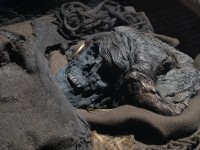In 2015, a team of researchers from the National Museum of Denmark and the University of Copenhagen announced that Egtved Girl, a Bronze Age woman whose well-preserved, beautifully appointed oak burial has made her an icon of Danish archaeology, was not from Denmark. Strontium isotope analysis of her molar and wool fibers found in the grave found that she most probably from southern Germany, most likely the Black Forest area.
Egtved Girl isn’t the only Bronze Age woman in Denmark buried in a hollowed-out oak coffin discovered in an exceptional state of preservation. Researchers have targeted three of them — Egtved Girl, Skrydstrup Woman and the Borum Eshøj Woman — as part of a study that examines the origins and mobility of these women whose rich grave goods and elaborate burials attest to their high social status. The Tales of Bronze Age Women study aims to understand how elite women were perceived in Bronze Age society and what their origins and movements over time can tell us about their roles in establishing and reinforcing long-distance trade networks, political alliances and cultural exchanges.
 Skrydstrup Woman was certainly a person of great importance in her community. Her remains were unearthed in a burial mound in Southern Jutland in 1935. One of the richest Bronze Age burials ever discovered, her wool skirt and sweater were in exceptional condition. Attached to her woven belt was an ornate comb made of horn. She wore two large spiral earrings made of gold and a necklace. Her blonde hair was two feet long, intricately plaited in multiple braids then drawn up into an updo bound by a horse-hair hairnet. Her teeth were in fantastic condition, with thick, clean layers of enamel and not a single cavity, evidence that she had had a healthy, varied diet as a child.
Skrydstrup Woman was certainly a person of great importance in her community. Her remains were unearthed in a burial mound in Southern Jutland in 1935. One of the richest Bronze Age burials ever discovered, her wool skirt and sweater were in exceptional condition. Attached to her woven belt was an ornate comb made of horn. She wore two large spiral earrings made of gold and a necklace. Her blonde hair was two feet long, intricately plaited in multiple braids then drawn up into an updo bound by a horse-hair hairnet. Her teeth were in fantastic condition, with thick, clean layers of enamel and not a single cavity, evidence that she had had a healthy, varied diet as a child.
Her elaborate hairstyle and clothing, too large and bulky to be practical for moving around in, had to have been arranged as part of her funerary treatment. It must have taken hours for the hair to be braided and styled, and the skirt, made from a single two meter-wide piece of fabric that was repeatedly folded at the waist to create even pleats that went all the way around the body, was also an extremely labour-intensive endeavor. The tumulus she was buried in was 13 meters (42.6 feet) in diameter and 1.75 meters (5.7 feet) high, all formed from thousands of pounds of peat that had to be harvested and arranged into the mound shape. The entire community had to be involved in creating such a time-consuming and resource-intensive grave.
 Since the sensational discovery of Egtved Girl’s origins, the research team has discovered that Skrydstrup Woman also moved to Denmark from foreign parts. Like Egtved Girl, she was only around 17 years old when she died in about 1300 B.C., but unlike Egtved Girl, who arrived on Jutland a year or so before her death, she had lived in Skydstrup for three or four years at the time of her death. Before she moved to Denmark as a young teen 13 or 14 years of age, Skydstrup Woman lived hundreds of kilometers away. The strontium isotope signature couldn’t pinpoint the exact location, but likely candidates include what are today the Czech Republic, France or central Germany.
Since the sensational discovery of Egtved Girl’s origins, the research team has discovered that Skrydstrup Woman also moved to Denmark from foreign parts. Like Egtved Girl, she was only around 17 years old when she died in about 1300 B.C., but unlike Egtved Girl, who arrived on Jutland a year or so before her death, she had lived in Skydstrup for three or four years at the time of her death. Before she moved to Denmark as a young teen 13 or 14 years of age, Skydstrup Woman lived hundreds of kilometers away. The strontium isotope signature couldn’t pinpoint the exact location, but likely candidates include what are today the Czech Republic, France or central Germany.
The new information about the famous Bronze Age remains was revealed on national broadcaster DR’s big-budget documentary series Historien om Danmark (The History of Denmark).
“This is going to change a whole lot about our understanding of the entire Bronze Age,” Professor Karin Margarita Frei of the National Museum of Denmark says in the programme. […]
“The result is important because it shows that the Egtved girl was not a freak occurrence. It appears there is a pattern that is telling us how people, and in this instance women, moved around during the Bronze Age,” Frei, who also led the Egtved girl study, told the broadcaster. [..]
The sudden long-distance migration may be the sign of an alliance between tribes or an arranged marriage, Frei told DR.
For more about the Tales of Bronze Age Women project, watch this overview video from the National Museum.
[youtube=https://youtu.be/JwCIkQGTTIw&w=430]
This video gives more detail about how strontium isotopes act as “nature’s GPS.”
[youtube=https://youtu.be/RHvy2Io0d94&w=430]